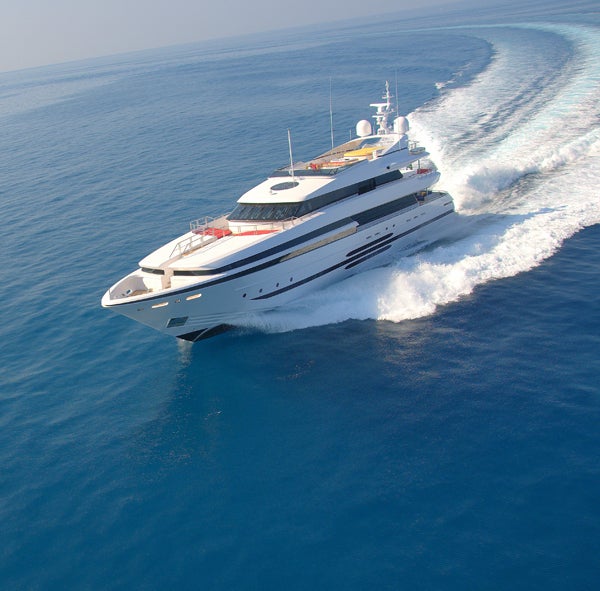

The Monaco Yacht Show is the showpiece event of the superyacht industry. When it was founded 25 years ago, the show featured just 30 yachts; this year, 120 of the world’s finest luxury yachts will be on display in Port Hercule, with 500 companies from 38 countries exhibiting and brokers, builders, designers and suppliers rubbing shoulders with prospective clients.
The show’s growth is an apt metaphor for the growth of the industry itself. When Yachting Partners International started business more than 40 years ago there were fourteen international yacht brokerage houses in the world. Today there are more than 150. The superyacht industry is estimated to generate more than €24 billion worldwide, employing more than 300,000 people, including around 30,000 working on the yachts.
The yachts are getting bigger. Back in 1991, the average length of a yacht on show at Monaco was 32 metres, this year it will be 47 metres – we have a 46-metre yacht, Balista (pictured below), on sale at Monaco for €19 million – and the last few years have witnessed a revolution in technology. Groundbreaking new materials are transforming their look and feel. Owners are getting the ultimate in comfort and luxury, combined with unbeaten efficiency and performance.

A new generation of owners have pushed yacht sales volumes to record highs. Last year, more than €3.2 billion of yachts over 24 metres in length were sold worldwide. New markets have opened up or been revived, including Russia, the Middle East and parts of Asia.
In the fall-out from the financial crisis, supply outstripped demand, bringing down prices. But this year, for the first time since the global meltdown, demand is outstripping supply and prices are slowly edging up again.
What does that mean if you aspire to enter the market as an owner? Where can you find the best value? And, as a novice, how do you avoid the obvious pitfalls?
The first thing to say is that approaching the superyacht market from a strict investment perspective is rarely a good idea. Buying a yacht tends to be an emotional decision, rather than a rational business decision.
Buying a 24-metre yacht – the entry point for the superyacht market – would normally cost upwards of £4 million, and, on top of that, you need to factor in the running and upkeep of the yacht. That accounts for around 10 per cent of the purchase value and covers crew, maintenance, insurance, berthing and such like. New yachts depreciate quickly – they commonly lose 15 per cent of their value for the first two years and another 10 per cent for each of the next three years.
The pre-owned market can offer better value. More than 2,000 well-maintained, high-quality yachts are on sale today. Many of them have excellent re-fit potential, giving owners the chance to customise their yacht to suit their family’s tastes and needs.
It’s the complexity of the market which can be off-putting. Using a broker allows you to find out what is on the market – and, more importantly, what is privately for sale but not being advertised – together with the condition and maintenance or re-fit history of those yachts.
Price alone is often not the best indication of value. You are paying a broker for their knowledge and the better the broker the more you will find out about the potential for future chartering, running and crewing costs and the eventual re-sale price.
Twenty-five years ago professional yacht management companies didn’t exist. Today, for yachts over 40 metres they are essential. Regulations introduced in recent years have imposed a plethora of tax charges and legal requirements on yachts entering territorial waters.
The imposition of the Maritime Labour Convention 2006 on the yachting industry two years ago means employment codes and conventions now apply to yachting crew just as they do to seafarers in the shipping industry. The amount of administration and paperwork required to run a yacht have made it a full-time business.
If all that is beginning to sound off-putting, there are two alternatives – employ the services of a professional yacht management company or charter a yacht instead. The charter industry has opened up the world of luxury yachting to a generation that would never otherwise have known it existed. Around 1,400 superyachts, out of a total fleet of around 6,000 – are available for charter.
Chartering a yacht gives you the privacy and freedom of a luxury holiday against the ever-changing backdrop of the Mediterranean or Caribbean. You choose the destination and the itinerary, enjoying all the unique features of the yacht and the services of a dedicated crew without the responsibilities that go with ownership.
Two years ago, a 72-metre yacht called Axioma caused a sensation when it was unveiled at the Monaco Yacht Show and sold on the show’s penultimate day. But it hasn’t disappeared from view – far from it.
The owners decided to charter it and in its first year it generated more than $7 million, a great return for its owners. Available for charter exclusively through YPI, it has also given an unforgettable experience to the families who have holidayed on it and enjoyed the unique hospitality of the twenty-strong crew.
It illustrates how the yachting industry has broadened its scope, becoming broader, more versatile and more welcoming to a new generation. It explains why this year’s Monaco Yacht Show will be the biggest and most spectacular the industry has ever staged.
The Monaco Yacht Show runs from 23-26 September
Mark Duncan is Commercial & Marketing Director of Yachting Partners International








